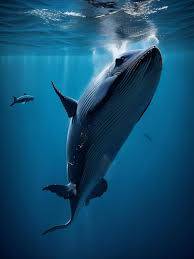The Majestic Blue Whale: Earth's Largest and Most Magnificent Giant.
In the vast expanses of the world's oceans, the blue whale reigns supreme as the largest creature to have ever graced our planet. This magnificent marine mammal, scientifically known as Balaenoptera musculus, captivates both scientists and nature enthusiasts alike with its colossal size and graceful presence.
The sheer enormity of the blue whale is staggering. Stretching up to 100 feet in length and weighing as much as 200 tons, these marine giants make even the most significant land mammals seem minuscule in comparison. Their tongues alone can outweigh an elephant, and their hearts, the size of a small car, pump an impressive amount of blood through their massive bodies.
What truly sets the blue whale apart is its unique blue-gray coloration and mottled appearance. As sunlight penetrates the water, it interacts with the whale's skin, creating a mesmerizing play of light and shadows. This distinctive coloration, coupled with the immense size, allows for easy identification of this remarkable species.
Blue whales are found in oceans across the globe, from the Arctic to the Antarctic. Despite their colossal size, they are filter feeders, primarily consuming small shrimp-like animals called krill. To feed, a blue whale opens its gargantuan mouth, engulfing a volume of water that can exceed its own body size. The water is then expelled through the baleen plates, leaving behind trapped krill for the whale to consume.
The hauntingly beautiful sounds of the blue whale's vocalizations add another layer to their mystique. These low-frequency calls, often reaching infrasound levels, can travel for hundreds of miles underwater. Scientists believe that these vocalizations play a crucial role in communication, mating, and possibly navigation across the vast ocean expanses.
Despite their awe-inspiring size, the blue whale faces significant threats, primarily from human activities. Historical whaling nearly drove these majestic creatures to the brink of extinction, and while international efforts have led to their protection, they still face challenges from ship strikes, climate change, and ocean noise pollution.
In conclusion, the blue whale stands as a testament to the marvels of the natural world. Its colossal size, distinctive appearance, and haunting calls evoke a sense of wonder and reverence. As we strive to protect Earth's largest inhabitants, the blue whale serves as a symbol of the importance of conservation and our responsibility to safeguard the incredible biodiversity that graces our planet's oceans.


